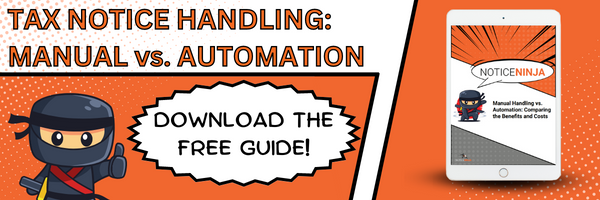Yes, NOTICENINJA is corporate tax notice compliance software that automates key workflows including notice assignments. The platform employs a rule-based system that can manage multiple level rules and ensure notices are directed to the appropriate stakeholder. As a result, you’ll never have to worry about notices being misdirected or slipping between the cracks.

The Most Common Tax Notices You'll Receive

24 February
When you receive a tax notice, the first reaction is usually resentment. Business owners who don't have sufficient experience with IRS communications tend to imagine the worst and don't respond fast enough.
In reality, tax notices provide valuable information that keeps your business compliant. They allow you to react quickly, prevent fines, and even receive a tax credit. Not all tax notices are created equal and hardly all are bad news.
Let's take a closer look at the most common tax notices and the actions they require.
What are the Most Common Notices Businesses Receive from the IRS?
The majority of tax notices you receive require a reply. Open the letter or email as soon as it arrives to ensure you respond promptly.
1. Notice of Balance Due
Notice of balance due (CP14) is a notification of unpaid taxes. When you receive this notice, you have 21 days to make a payment. If you don't pay within 60 days, you may face collection activity from the IRS.
If you don't agree with the amount in the notice, you can contact the IRS and explain your case. If, for some reason, you can't afford to pay, notify the IRS to arrange a payment plan.
2. Notice of Failure to File
If you don't file a tax return by the due date, you may receive a notice of failure to file. This notice advises you of a penalty you owe for failing to file your taxes.
The failure to file a penalty is 5% of the taxes you didn't pay for each month the tax return is late. You can avoid paying the penalty if you provide an adequate reason for filing late. You can also dispute the penalty.
If you don't respond to the notice, penalties will continue mounting.
3. Notice of Failure to Pay
If you don't pay your taxes by the due date, the IRS will send you a notice of failure to pay. You would need to pay a penalty of 0.5% of any taxes you owe after the due date monthly until you finally make a payment.
You can remove the penalty if you provide reasonable grounds for not paying on time. Failing to react to the notice results in more penalties.
4. Notice of Information Provided
If you receive a request for information (12C), the IRS requires more information to process your tax returns. For example, you may need to provide additional documents, forms, or verifications.
To resolve the notice, you must send additional information to the IRS within 20 days.
5. Earned Income Credit (EITC)
The IRS will send you a notice if you qualify for Earned Income Credit. To claim the credit, you must complete the eligibility form and send it to the IRS. Once you do that, you can expect a refund within eight weeks.
6. Notice of Deficiency
The IRS sends this notice if the amount of taxes you reported on the return differs from what the IRS believes you owe. The amount can be either higher or lower.
If you agree with the adjusted amount, you must sign the enclosed form and return it to the IRS. If you don't, you can contact the IRS and negotiate. If you don't come to an agreement, you can file a petition with the U.S. Tax Court.
7. Notice of Audit
If the IRS plans to audit your account, they send a notice of audit. The IRS may also request documents to help it conduct the audit.
When you send any documents to the IRS, ensure you receive a receipt confirmation.
8. Notice of Determination
After the IRS completes the audit, they send a Notice of Determination. This notice contains the results of your audit. You can either pay the additional amount (if any) that the audit discovered or file an appeal.
If you plan to file an appeal, you have to do so within 30 days of receiving the notice.
How to Keep Tax Notices in Check
.png?width=167&height=167&name=Untitled%20design%20(5).png) The majority of common tax notices require a reply. Many of them mean you owe the IRS money or have to pay penalties. Failing to respond usually leads to additional expenses.
The majority of common tax notices require a reply. Many of them mean you owe the IRS money or have to pay penalties. Failing to respond usually leads to additional expenses.
To minimize negative communication with the IRS, you can use automation software. It can manage your tax notices, monitor updates, send documents to the right person, and simplify the reply process. Staying organized and on top of your notices is the best course to prevent penalties and additional payments. Manually handling your notices can cause them to get lost, which can inadvertently lead to late payments and infractions.
Responding to the Most Common Tax Notices
While communication with the IRS is hardly exciting, it's part of doing business. You can minimize penalties, avoid reputational issues, and prevent downtime by ensuring you respond to notices on time.
Don't ignore letters that IRS sends you. Work out a tax notice management strategy to help you provide timely responses without interfering with daily business operations.

